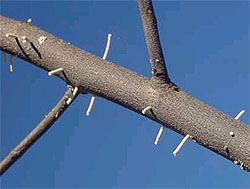Are ambrosia beetles important?
Ecological importance

Fig: Ambrosia beetle mass colonization of a freshly dead tree in a tropical rainforest. Photo J.H.
Ambrosia beetles are usually the first agent of wood degradation to arrive on a dead tree. This is not as apparent in the temperate zones, especially in dry ecosystems. However, in the tropics or in a healthy temperate conifer forest, ambrosia beetles colonize dead trees en masse, and by drilling through the bark deep into the wood, they open up the tree tissues for symbiotic as well as general wood-degrading fungi.
Because so much of Earth’s carbon is locked up in the form of trees, understanding the specific mechanisms of how wood decays may be critical to modeling climate change. Invasive beetles and their fungi that may impact wood decay could alter existing trajectories of global warming.
Economic importance
Most ambrosia beetle species are cryptic organisms living in rotten wood, entirely inconsequential to human society. A small number of species, however, are among the most prolific invasive species worldwide (Faccoli, 2008; Haack, 2006; Jordal et al., 2000), and the damage they cause to forests and the timber industry parallels that by the more notorious tree-killing bark beetles (Fraedrich et al., 2008).
Nobody knows why (yet), but when they are introduced to a non-native land mass, some ambrosia beetle species from tropical and subtropical regions of the world start attacking and colonizing live trees. Usually only a small subset of trees is susceptible to the non-native ambrosia beetles. The most likely trigger of such devastating invasions appears to be a coincidental ‘evolutionary mismatch’ between the attacked species of tree and the beetle-fungus couple. Remember that this only happens when a beetle is introduced to a non-native region, where trees have not had the chance to evolve the proper responses.
Two features tend to make certain tree hosts vulnerable to being attacked: 1) the tree species smell like freshly dead trees to the beetles even if they are perfectly healthy, and 2) the immune system of the tree over-reacts to the presence of the strange new fungus, to the point that the tree kills itself. For more details on these hypotheses see Hulcr & Dunn (2011).

Fig: Attack of Xylosandrus crassiusculus on a live fruit tree in Texas. Photo R. F. Billings, Texas Forest Service.
Current examples of the most damaging ambrosia beetle-fungus couples:
- Xylosandrus crassiusculus and Xylosandrus germanus were brought to the United States from an unknown subtropical region a few years ago and started to attack and kill orchard trees.
- Platypus quercivorus has been in Japan for a long time, mostly regarded as a harmless secondary ambrosia beetle. Recently the species emerged as a major mortality agent in oak forests. The tree death is caused by its ambrosia fungus Raffaelea quercivora (Hijii et al., 1991).
- Megaplatypus mutatus is a newly discovered pest in poplar stands in many regions of the world where it was accidentally introduced, potentially causing troubles for the bioenergy industry (Alfaro et al., 2007).
- Several species native to temperate and boreal ecosystems, namely Gnathotrichus and Trypodendron spp., cause significant structural and esthetic damage to conifer timber industry (Orbay et al., 1994).
- The worst is arguably the recently introduced duo of Xyleborus glabratus and its symbiotic Raffaelea lauricola, which are spreading rapidly throughout the southeastern United States, exterminating trees from the laurel family (Fraedrich et al., 2008). In August of 2009 they were recorded attacking avocado trees in Florida for the first time (avocados are also in the Lauraceae). There are no methods for mitigating the spread of this symbiotic complex. Unless drastic and ingenuous measures are taken, this ambrosia complex may devastate the avocado industry in Florida. Should it be also introduced in the west coast, the damage may be unimaginable, since the laurel tree is the dominant species in California’s forests, and the Californian avocado industry is equally important. If it also reaches Mexican avocado plantations then avocadoes could functionally disappear from American cuisine.
References
Alfaro, R.I., Humble, L.M., Gonzalez, P., Villaverde, P., & Allegro, G. (2007) The threat of the ambrosia beetle Megaplatypus mutatus (Chapuis) (=Platypus mutatus Chapuis) to world poplar resources. Forestry, 80, 471-479.
Faccoli, M. (2008) First record of Xyleborus atratus Eichhoff from Europe, with an illustrated key to the European Xyleborini (Coleoptera: Curculionidae: Scolytinae). Zootaxa, 1772, 55-62.
Fraedrich, S.W., Harrington, T.C., Rabaglia, R.J., Ulyshen, M.D., Mayfield, A.E., Hanula, J.L., Eickwort, J.M., & Miller, D.R. (2008) A fungal symbiont of the redbay ambrosia beetle causes a lethal wilt in redbay and other Lauraceae in the southeastern United States. Plant Disease, 92, 215-224.
Haack, R.A. (2006) Exotic bark- and wood-boring Coleoptera in the United States: recent establishments and interceptions. Canadian Journal of Forest Research, 36, 269-288.
Hijii, N., Kajimura, H., Urano, T., Kinuura, H., & Itami, H. (1991) The mass mortality of oak trees induced by Platypus quercivorus (Murayama) and Platypus calamus Blandford (Coleoptera: Platypodidae): the density and spatial distribution of attack by the beetles. Journal of the Japanese Forestry Society, 73, 471-476.
Hulcr & Dunn (2011) The sudden emergence of pathogenicity in insect-fungus symbioses threatens naive forest ecosystems. Proceedings of the Royal Society B- Biological Sciences (in press).
Jordal, B., Normark, B.B., & Farrell, B.D. (2000) Evolutionary radiation of an inbreeding haplodiploid beetle lineage (Curculionidae, Scolytinae). Biological Journal of the Linnean Society, 71, 483-499.
Orbay, L., McLean, J.A., Sauder, B.J., & Cottell, B.L. (1994) Economic losses resulting from ambrosia beetle infestation of sawlogs in coastal British Columbia, Canada. Canadian Journal Of Forest Research-Revue Canadienne De Recherche Forestiere, 24, 1266-1276.
